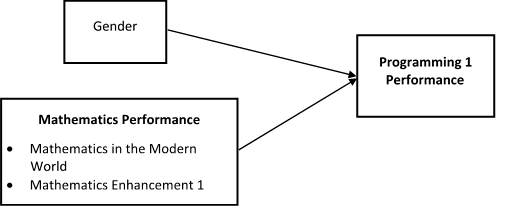


Indian Journal of Science and Technology
Year: 2020, Volume: 13, Issue: 26, Pages: 2668-2677
Original Article
Eduardo Edu C Cornillez Jr.1*, Jasten Keneth D Treceñe2, Jessie Richie N de los Santos2
1Teacher Education Department, Eastern Visayas State University, Tanauan Campus, Philippines. Tel.: (+63)926-641-6960
2Engineering Department, Eastern Visayas State University, Tanauan Campus, Philippines
*Corresponding author
Tel.: (+63)926-641-6960
Email: [email protected]
Received Date:25 May 2020, Accepted Date:26 June 2020, Published Date:30 July 2020
Objectives: The aim of this study was to investigate the influence of mathematics to the programming performance of Information Technology students and identified the relationships of their performance in programming among genders. Methods/Statistical analysis: The study utilized the data mining method using J48 classification algorithm and descriptive-correlation design. The data were gathered from Electronic Database of the University. Failure ratings of the students were removed as significant outliers and came up with 73 data sets. Pearson r and Point Biserial Correlations were used with 0.05 level of significance alpha to test the correlation between continuous measures of independent and dependent variables. Further, descriptive statistics were used to describe the level of performance in mathematics and programming. Findings: The results show that students demonstrated a high performance in their mathematics in the modern world course with a mean rating of 2.16 (SD=0.27), and a low performance in their mathematics enhancement 1 with a mean grade of 2.81 (SD=0.38). Similar result in their programming course with a mean grade of 2.64 (SD=0.39). The mathematics performance of the students is significantly correlated to their performance in programming. The low performance in mathematics enhancement 1 corresponds to the low performance in programming. Moreover, female students performed better in their programming course compared to males. Applications: The results could help the teachers improve the quality of instructions particularly in mathematics and programming that will improve the performance of the students in both subjects. Concerned University administrators should conduct frequent assessments and curriculum revisits to examine possible areas of improvement beneficial to the students.
Keywords: Mathematics performance; programming performance; data mining; correlation; point biserial; J48 algorithm
© 2020 Cornillez Jr., Treceñe, de los Santos. This is an open-access article distributed under the terms of the Creative Commons Attribution License, which permits unrestricted use, distribution, and reproduction in any medium, provided the original author and source are credited. Published By Indian Society for Education and Environment (iSee)
Subscribe now for latest articles and news.